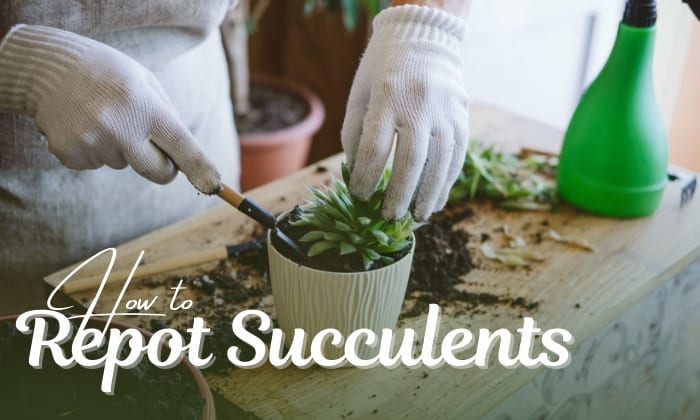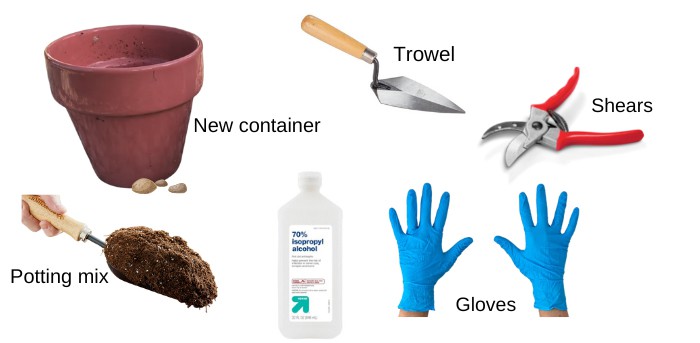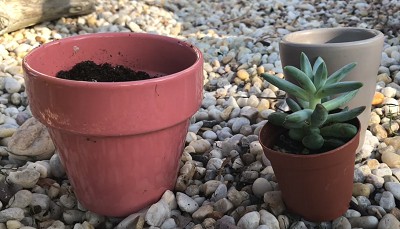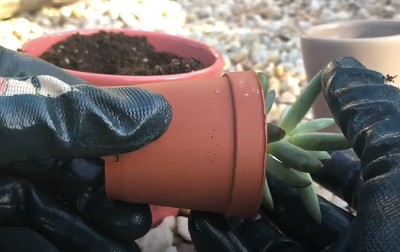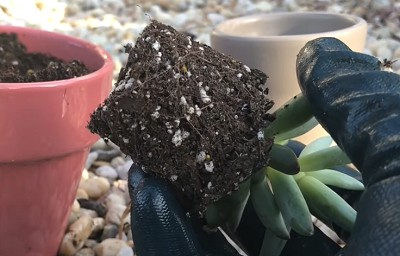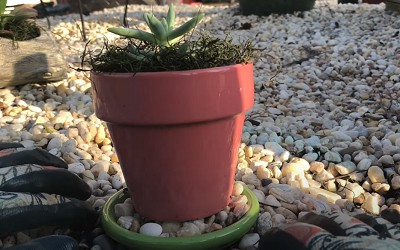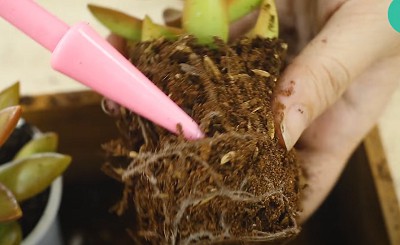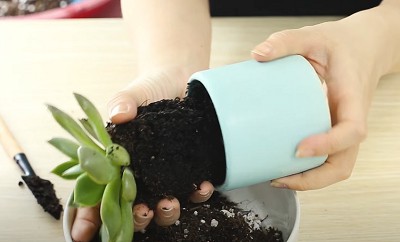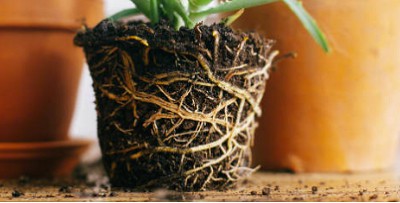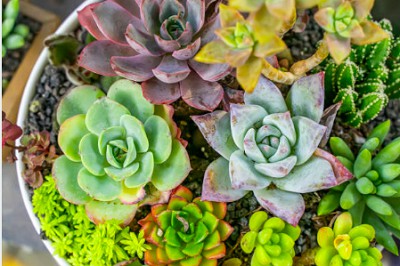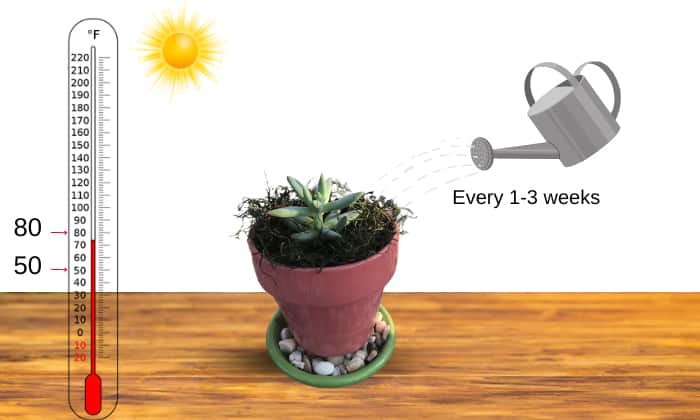Low-maintenance and colorful, succulents are available in thousands of exquisite varieties that appeal to homeowners everywhere. If you just got a new succulent and want to repot it, rest assured that the steps are very simple.
Simply remove the plant from its container, separate the roots, and put it in a new pot with soil. Read below for detailed instructions on how to repot succulents.
Table of Contents
Best Way to Repot Succulents
What to prepare
- New potting mix
The best soil for repotting succulents must be well-drained and grainy, with organic matter but no vermiculite.
You should use a store-bought succulent mix to be safe. Find a product that suits your plant variety, or experiment with making your own if you’re okay with trial and error.
A basic formula contains equal parts of sand and regular potting soil with half as much pumice or perlite.
- New container
The pot for replanting succulents must be two inches wider than the plant and have a drain hole at the bottom. Do not line the base of the container with rocks, as they won’t help your succulent anyway; if you must improve drainage, place a coffee filter there instead.
Regarding materials, terracotta, ceramic, plastic, and wood will all do. Note that plastic is less breathable than terracotta and ceramic, which tend to overheat more compared to wood.
Avoid repotting overgrown succulents in metal containers, as they’re susceptible to rust and temperature fluctuations. Glass is also a lousy choice due to its fragility and poor drainage.
- Gloves
- 70% rubbing alcohol to sanitize cutting tools (a higher concentration is also acceptable)
- Shears or scissors
- Water
- Trowel
- Stick (optional)
Steps to Follow
Step 1. Put the potting mix into the new container and remove the plant.
- Fill 75% of the new container with the plant mix you prepared.
- Lay the old container on its side or flip it over to get the succulent out. You can shake the pot a bit and run a stick along the rim to loosen the soil as well.
Whatever you do, remember to water the soil a day before moving succulents to bigger pot. This measure will help the plant survive uprooting, since we can’t irrigate it immediately after changing pots.
Step 2. Check the plant and trim off dead or diseased parts.
- Use your fingers to separate the roots of the plant. This step will help them settle into the new soil more quickly, since the roots won’t be stuck together.
- At the same time, check the succulent for any dead foliage or stems that need cutting. Remove the roots with sterilized shears or scissors before you repot a plant. As for the dead leaves, simply pulling them out will be enough.
- Though cleaning the roots with water is optional, you should remove all old soil from them, particularly if the soil has pests, disease, or too much compaction. In this case, let the roots dry at room temperature after washing the dirt off.
Step 3. Transfer succulents to pot.
Place the succulent into the soil, ensuring you bury the roots but not the leaves. Wait a week to water succulents after repotting. At this point, they should have adapted to their new environment and shouldn’t experience shock from irrigation.
When Should You Repot Succulents? Why?
Succulents need to be repotted if:
- The roots are sticking out of the container.
This state indicates that they are constricted. Without a larger pot to grow in, your succulent will not expand or receive enough nutrients.
- The leaves have wilted or look dead despite proper care.
It’s possible that the soil is infertile, especially if you never apply fertilizer or the container has been in use for many years.
When this happens, drainage may be compromised, resulting in failure to retain moisture and brown, brittle leaves.
- There are pests, root rot, or other external factors impairing the health of the plant.
In this case, the problems may have infected the soil already, making it imperative that you give your plant a healthy medium to grow in.
- Your large succulents are extremely top-heavy and can’t stay upright in their current container.
To solve this issue, move them to bigger, more stable pots. Plants that are too tall will need containers 10% higher than them.
- You’ve recently brought succulents home after buying them.
Often, stores that sell succulents use heavy soil and small pots that don’t suit these plants.
Plus, premade mini gardens may have glued-on rocks and accessories that prevent moisture from reaching plant roots. Repotting succulents from store allows them to thrive under proper conditions.
Tips for Repotting Succulents
- Repot baby succulents if you like having multiple small plants.
Follow the same process we described above, but split the succulent before repotting it. The babies or offshoots are often at the plant’s bottom and attached to a stem. You should cut them off, then let them dry and harden before transplanting.
And remember—small babies or offshoots are weaker than their mature counterparts, so wait until these parts are half as big as the main succulent before removing them.
- If you don’t have enough pots for all of your plants, repot succulents together in one container.
The container should be expansive, allowing all plants to spread with at least an inch of space between the saplings.
I must emphasize, though—do not put various succulents in one place when they have different needs regarding sunlight, water, etc.
As an example, Crassula and Graptosedum plants won’t play well together, while aloe and kalanchoe will make wonderful neighbors.
Creating a succulent arrangement is similar to repotting. Just remove your plants from their containers. If you break any roots in the process, let them harden and dry before transplanting.
How to Care for Succulents After Repotting
After transferring succulents, water them every one to three weeks or whenever the top two inches of the soil turn dry.
Each time, pour in enough liquid to wet the container base and drain holes without letting too much moisture touch the leaves, and make sure to reduce your watering frequency during plant dormancy. Once or twice during this period should suffice.
Place the container under bright, indirect light if transplanting succulents indoors, and beware of humidity if you put your pots outside. Full sun exposure may mean daily watering, depending on how hot the weather is.
In any case, do not put your succulent in a windy location. Give the plant a temperature of 50 to 80℉ and move it indoors if the weather’s colder than this range.
Refrain from fertilizing during the first two, possibly three months, after repotting. Applying plant food too early will hurt rather than help the roots.
FAQs
Can repotting succulents kill them?
Is it bad to replant succulent outgrowing pot? Well, there’s always a chance your plant won’t make it, especially if it was already sick before transplanting.
However, succulents are adaptable, and with the right soil and care from you, they should start to recover in about two weeks.
Can you repot succulents in fall or winter?
The best time to repot succulents depends on their dormant season. If your variety stops growing during summer, then repotting it in the fall is ideal.
Changing containers in winter is a no-go, since succulents that aren’t dormant in summer become inactive in winter instead. For these types, spring is the best repotting period.
How to progate succulents?
Start by removing a cutting that’s four to five inches long from the plant, then let it form a callus under bright indirect sunlight.
The callus should then go into a succulent mix to form roots. For successful propagation, water the top inch of the mix, so it’s damp.
That’s it! You’ve finished repotting succulents cuttings.
How often should you repot succulents?
Once every two years is a good rule of thumb. You should also see if the roots are visible outside of the container. It is the most obvious sign your succulent needs more space.
Conclusion
Learning how to repot succulents is straightforward. Most people will probably memorize the steps in five minutes or less, and with all the necessary tools at hand, the task will require fifteen minutes at most.
So, have fun repotting your succulents, and send us your questions if you have any.
Read more other tips on repotting Money Tree, and Rubber plant,...

Hi, I am William – Floridayards’ digital content creator. My job is to find answers to all your concerns with thorough research and our team’s expert advice. I will also bring you honest reviews on the best products and equipment for raising your beautiful garden. Please look forward to our work!


